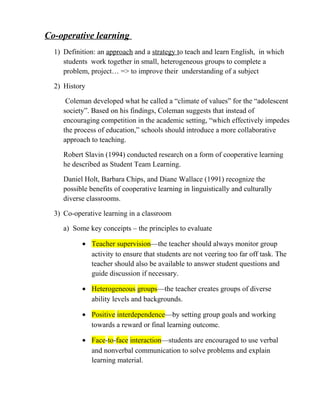
Cooperative
- 1. Co-operative learning 1) Definition: an approach and a strategy to teach and learn English, in which students work together in small, heterogeneous groups to complete a problem, project… => to improve their understanding of a subject 2) History Coleman developed what he called a “climate of values” for the “adolescent society”. Based on his findings, Coleman suggests that instead of encouraging competition in the academic setting, “which effectively impedes the process of education,” schools should introduce a more collaborative approach to teaching. Robert Slavin (1994) conducted research on a form of cooperative learning he described as Student Team Learning. Daniel Holt, Barbara Chips, and Diane Wallace (1991) recognize the possible benefits of cooperative learning in linguistically and culturally diverse classrooms. 3) Co-operative learning in a classroom a) Some key conceipts – the principles to evaluate • Teacher supervision—the teacher should always monitor group activity to ensure that students are not veering too far off task. The teacher should also be available to answer student questions and guide discussion if necessary. • Heterogeneous groups—the teacher creates groups of diverse ability levels and backgrounds. • Positive interdependence—by setting group goals and working towards a reward or final learning outcome. • Face-to-face interaction—students are encouraged to use verbal and nonverbal communication to solve problems and explain learning material.
- 2. • Individual accountability—students are accountable for their tasks and for assisting the whole group meets learning goals. This accountability is enforced through student roles. • Social skills—the teacher needs to establish rules so that all students are respectful, speak in a manner appropriate to the classroom setting, and utilize their time wisely during group interaction. • Group processing—students engage in reflection on how the group functioned during activity. • Evaluation—all activities should include both individual and group assessment. b) Cooperative Learning Techniques b1) Discussion: communicating think-pair –share : the think-pair-share structure provides students with the opportunity to reflect on the question posed and then practice sharing and receiving potential solutions. Its simplicity provides instructors with an easy entry into cooperative learning and it is readily adaptable to a wide range of course constructs. Three-step interview: This structure can be used both as an ice-breaker which introduces students to one another and to provide students with a venue for soliciting opinions, positions, or ideas from their peers. Students are first paired and take turns interviewing each other using a series of questions provided by the instructor. Pairs then match up and students introduce their original partner. At the end of the exercise, all four students have had their position or viewpoints on an issue heard, digested, and described by their peers. b2) Reciprocal teaching: explaining, providing feedback, understanding alternative perspectives Note-taking pair : Designing an exercise which requires students to summarize their understanding of a concept based on notes taken (with directed questions such as what is the definition of a concept, how is it
- 3. used, what are the three most important characteristics of a topic) and receiving reflective feedback from their partner provides students the opportunity to find critical gaps in their written records. Jigsaw: structure provides students the opportunity to develop expertise in one of many components of a problem by first participating in a group solely focused on a single component. In the second stage of the exercise, groups are reformed with a representative from each expert group who together now have sufficient expertise to tackle the whole problem. b3) Graphic organizers: discovering patterns and relationships Group- grid: Students practice organizing and classifying information in a table. A more complex version of this structure requires students to first identify the classification scheme that will be used. Sequence chains: The goal of this exercise is to provide a visual representation of a series of events, actions, roles, or decisions. Students can be provided with the items to be organized or asked to first generate these based on a predetermined end goal. This structure can be made more complex by having students also identify and describe the links between each of the sequenced components. b4) Problem solving: developing strategies and analysis Send-a-problem: Students participate in a series of problem solving rounds, contributing their independently generated solution to those that have been developed by other groups. After a number of rounds, students are asked to review the solutions developed by their peers, evaluate the answers and develop a final solution. Three-stay, one-stray: Even students working in groups can benefit from the feedback of additional peers. In this structure, students periodically take a break from their work (often at key decision making points) and send one group member to another group to describe their progress. The role of the group is to gain information and alternative perspectives by listening and sharing. The number of times the group sends a representative to another group depends on the level of complexity of the problem. This method can also be used to report out final solutions.
- 4. 4) Why we should use Results of co-operative learning and teaching include improved academic achievement, improved behavior and attendance, increased self-confidence and motivation, and increased liking of school and classmates. Cooperative learning is also relatively easy to implement and is inexpensive.
